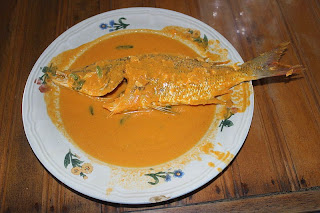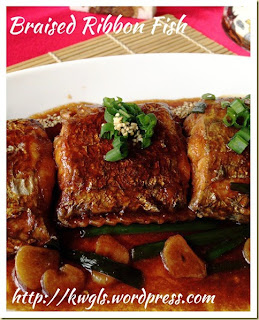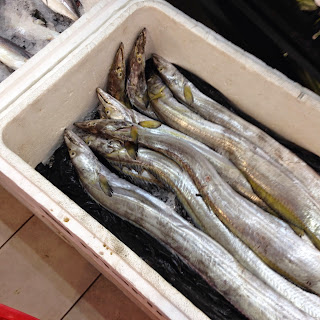Firstly, we look at the flesh/ meat of the fish.
The meat/ flesh of the fish should be firm and not mushy & soft.
So the meat/ flesh should be able to bounce back when pressed with your fingers.
Secondly, we should use our sense of smell to smell if the fish is fresh.
By sniffing, we smell if the fish smell fresh (like the ocean/freshwater) which shows that it is fresh or has a fishy smell which indicates that it is not fresh.
Thirdly, we should use our sense of sight to check the eyes of the fish if the head is still intact.
By observing, we check to see if the eyes of the fish is cloudy (not fresh) or if it is fresh, it is supposedly bright & clear. The eye should be also be a little bulging if it is fresh.
Fourthly, the gills of the fish if sold in whole should be bright pink/ red and wet, and not suppose to be dry/ slimy.
Fifth, if the fish is being bought in fillets/ steaks, it should not be bruised. It should be moist with no form of discolouration. The flesh/ meat should also not separate from itself or any forms of gaps in the meat, as it indicates that the fish is not fresh.
Lastly, if there is any signs of brown/ yellow edges with a spongy consistency and discolouration, it shows that the fish is aging and the fish might not be fresh.
Above are the steps to check to ensure the fish you buy is fresh and have a good quality.
Fish-tionary - The fish dictionary
Friday 15 May 2015
Thursday 14 May 2015
Red-Spotted Grouper
Red-spotted Grouper is also known as 红斑(hong ban) in Chinese.
They are commonly found in rocky marine waters (sea or ocean)
The market price is around $18-$24/kg.
They have a stout body and a large mouth. They do not have many teeth on the edges of their jaws but have large tooth plates to crush their food. Their mouth and gills are very powerful, which can suck their prey from a distance.
Their meat is firm with heavy flakes but still remains moist even after cooking, with a mild flavour it can be use to cook an Indonesian & South Indian fusion dish: Red Grouper Curry (Gulai Kerapu)
The fish is being browned on both sides and aromatic spices and herbs are added like turmeric, galangal and green chilies.
Cocnut milk and stock will be then added with assam to finish off the dish.
They are commonly found in rocky marine waters (sea or ocean)
The market price is around $18-$24/kg.
 |
| The red-spotted grouper is the fish at the top red hand corner. |
They have a stout body and a large mouth. They do not have many teeth on the edges of their jaws but have large tooth plates to crush their food. Their mouth and gills are very powerful, which can suck their prey from a distance.
Their meat is firm with heavy flakes but still remains moist even after cooking, with a mild flavour it can be use to cook an Indonesian & South Indian fusion dish: Red Grouper Curry (Gulai Kerapu)
 |
| image by, Ramzy Muliawan @ wikimedia.org |
The fish is being browned on both sides and aromatic spices and herbs are added like turmeric, galangal and green chilies.
Cocnut milk and stock will be then added with assam to finish off the dish.
Salmon
Salmon is also known as 三文鱼 (san wen yu) in Chinese.
They are known as migratory fishes. They are born in freshwaters like rivers or lakes but they will migrate to the sea/ocean to live. When during the mating season around end October to early November they will swim back their birth place to reproduce and dies there.
The market price for medium sized salmon is about $18.90 for a whole fish.
It is considered as an oily fish, but a great source of protein and essential fatty acids. The flesh of the salmon is usually red to orange in colour and having some carotenoids pigments in the flesh.
A very popular way of eating fresh salmon in Japan is Salmon Sashimi. It is usually eaten with soy sauce and wasabi. It can also be put on top of a sushi rice.
Due to it's delicate flavour and tender texture, it is usually enjoyed raw for it's freshness and natural taste and flavour. They are also distinguished by its rosy-pink colour.
They are known as migratory fishes. They are born in freshwaters like rivers or lakes but they will migrate to the sea/ocean to live. When during the mating season around end October to early November they will swim back their birth place to reproduce and dies there.
The market price for medium sized salmon is about $18.90 for a whole fish.
It is considered as an oily fish, but a great source of protein and essential fatty acids. The flesh of the salmon is usually red to orange in colour and having some carotenoids pigments in the flesh.
A very popular way of eating fresh salmon in Japan is Salmon Sashimi. It is usually eaten with soy sauce and wasabi. It can also be put on top of a sushi rice.
 |
| image by, imgsoup.com |
 |
| image by, http://www.satsuma-sushi.com/nigril |
Small Shark
Small Shark which is known as 小鲨鱼 (xiao sha yu) in Chinese.
They are usually found in the deep oceans and seas and are usually quite large in size.
They generally do not live in freshwater.
The market only sell smaller scale of sharks around 35-40cm long and the market price is around $11/kg.
Sharks have a covering of dermal denticles to protect itself from any damage and also several sets of replaceable teeth.
They are easily identified by the fins at the back of the shark.
They have 5-7 gills slits to help them in breathing.
It depends on the species for it's size and weight, and it varies differently.
The texture of shark is rather tough, the fins of the shark that is usually used for a very classic Chinese dish- Shark Fin's Soup are virtually tasteless but value for the texture.
But the meat of the shark s said to taste like chicken.
One example is a Teochew cold dish: Jellied Shark Meat (鲨鱼冻)- sha yu dong.
It is usually eaten chilled as an appetizer.
They are usually found in the deep oceans and seas and are usually quite large in size.
They generally do not live in freshwater.
The market only sell smaller scale of sharks around 35-40cm long and the market price is around $11/kg.
Sharks have a covering of dermal denticles to protect itself from any damage and also several sets of replaceable teeth.
They are easily identified by the fins at the back of the shark.
They have 5-7 gills slits to help them in breathing.
It depends on the species for it's size and weight, and it varies differently.
The texture of shark is rather tough, the fins of the shark that is usually used for a very classic Chinese dish- Shark Fin's Soup are virtually tasteless but value for the texture.
But the meat of the shark s said to taste like chicken.
One example is a Teochew cold dish: Jellied Shark Meat (鲨鱼冻)- sha yu dong.
 |
| image by, http://www.212teochewcuisine.com/menu |
It is usually eaten chilled as an appetizer.
Red Tilapia
Red Tilapia also known as 妮罗红(ni luo hong)in Chinese.
They are mainly freshwater fish that inhabit at shallow streams, ponds rivers and lakes.
The tilapia fishes are rather sensitive as they are unable to survive in water cooler than 21 degree Celsius.
They originated from Mediterranean & African countries.
The market price is around $9.90/kg.
It has a deep and compressed body.
They have a complex set of muscles and can be easily distinguish by it colour and it's wide and swollen lips.
Most wild tilapia nowadays are hybrid of several species.
Tilapia have very low mercury level, due to it being lean, short lived and fast growing.
They also have a vegetarian diet and thus they are low in saturated fats.
It is also a high source of protein.
Due to it's white lean meat, moderate texture and mild flavour, it is usually steamed.
Tilapia is a common fish in the Thai & Chinese cuisines.
One example is a Thai Cuisine: Tilapia steamed rolls in Soy Sauce (Bla Tub-Tim Neing Sea Eaw) as the fish is easy to slice and roll which is ideal for making this dish.
Firstly, the fish is being sliced and stuff with pounded garlic, coriander roots, shrimps, carrots and pepper and being rolled with seaweed.
It will be then drench with soy sauce and garnish with chillies and celery.
They are mainly freshwater fish that inhabit at shallow streams, ponds rivers and lakes.
The tilapia fishes are rather sensitive as they are unable to survive in water cooler than 21 degree Celsius.
They originated from Mediterranean & African countries.
The market price is around $9.90/kg.
| Red Tilapia is the fish in the middle. |
It has a deep and compressed body.
They have a complex set of muscles and can be easily distinguish by it colour and it's wide and swollen lips.
Most wild tilapia nowadays are hybrid of several species.
Tilapia have very low mercury level, due to it being lean, short lived and fast growing.
They also have a vegetarian diet and thus they are low in saturated fats.
It is also a high source of protein.
Due to it's white lean meat, moderate texture and mild flavour, it is usually steamed.
Tilapia is a common fish in the Thai & Chinese cuisines.
One example is a Thai Cuisine: Tilapia steamed rolls in Soy Sauce (Bla Tub-Tim Neing Sea Eaw) as the fish is easy to slice and roll which is ideal for making this dish.
 |
| image by, http://www.khiewchanta.com |
It will be then drench with soy sauce and garnish with chillies and celery.
Ribbon Fish
Ribbon Fish also known as 带鱼 (dai yu) in Chinese.
It is a salt water fish and in the deep waters of the Mediterranean waters.
They belong to the temperate plegic species that breed between June and October.
The market price is about $10.90/kg.
They have a long tape-like body, with a small head. Their fins and especially the membrane connecting it are very delicate and brittle.
They are rarely seen alive as they live in the deep water.
Due to it's delicate texture, fresh taste and less fish bones.
It is usually used to prepare a Shanghai home-cook dish: Braised Ribbon Fish (红烧带鱼) - hong shao dai yu
The fish is first coated with a layer of rice flour and pan-fry till golden brown.
Then it will be braised with black vinegar, dark soy sauce, pepper, ginger and some garlic till the desired texture and flavour.
It is a salt water fish and in the deep waters of the Mediterranean waters.
They belong to the temperate plegic species that breed between June and October.
The market price is about $10.90/kg.
They have a long tape-like body, with a small head. Their fins and especially the membrane connecting it are very delicate and brittle.
They are rarely seen alive as they live in the deep water.
Due to it's delicate texture, fresh taste and less fish bones.
It is usually used to prepare a Shanghai home-cook dish: Braised Ribbon Fish (红烧带鱼) - hong shao dai yu
 |
| image by, Kenneth Goh @ https://kwgls.wordpress.com |
Then it will be braised with black vinegar, dark soy sauce, pepper, ginger and some garlic till the desired texture and flavour.
Wednesday 13 May 2015
Yellowtail
Yellowtail also known as 黄尾鱼 (huang wei yu) in Chinese.
It is a salt water reef fish native to the western Atlantic Ocean including the Gulf of Mexico and the Caribbean Sea.
They can be identified by their greenish-yellow stripe which runs along the length of the body as well as the tail which is where the name "Yellowtail" comes from.
It has slightly sweet, white, fine and flaky flesh which is good to eat. Also, it has a very oily texture, however it is a very delicate and nutritious fish.
Commonly Used in Chinese Steamed Yellowtail
Subscribe to:
Posts (Atom)

